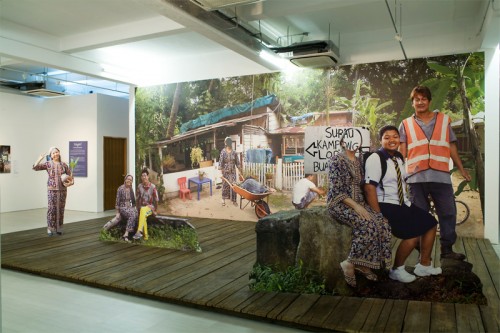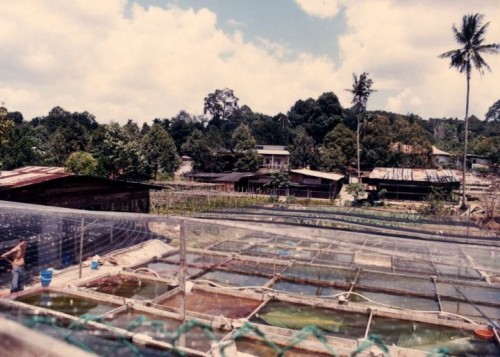In July I went to a residency program on Pulau Ubin Island, which is off the main island of Singapore. (Yes, I was on an island off another island). Pulau Ubin is tiny. It would take me just 45 minutes to bike across the entire island. But it represent a very unique contrast: in Singapore, a city state, where most people live in high-rises, spaces are highly regulated and controlled. The majority of of Palau Ubin Island’s natural resources are preserved. On weekends it is a popular destination among Singaporeans for hiking and biking trips. On the island, the artist residency living situation is basic, but sufficient. The electricity is powered by solar panels and water is pumped from a well. Compared to the rest of Singapore, it is a throwback to the past, with some charm and lots of mosquitoes. The residency is set up by a Singaporean art collective called the Artist Village. The aim of the program is to give artists an opportunity to work with nature, or so says the website. Yet, to me, it represents a little bit more than that.
Perhaps it would be useful for me to briefly introduce Pulau Ubin and the Artist Village. Pulau Ubin Island was just like the rest of the country, during the 1960’s anyway. Its population was about 4000 strong, all living in kampong-style houses, which can be found throughout Southeast Asia. But the country was moving forward. Post independence from Malaysia, Singapore government launched massive public housing projects (commonly referred to as House Development Board flats, or HBD flats) to replace kampongs and slums in the mainland. Meanwhile, urbanization never took place on Pulau Ubin; ways of life on the tiny island did not change very much. Well, except the population has dwindled to merely 50 residents while I was staying there. Yup, nothing really could get in the way of me and nature!
Members of the Artist Village have been called the first contemporary artists in Singapore. Artist Village was funded by Tang Da Wu in 1988; he and other artists found and built studio/gallery spaces at Lorong Gambas. For a lot of the artists in the collective, it was like living in a kampong again. It is also important to note that the Artist Village was at the forefront of pushing local art into new discourses. They played instrumental roles in introducing installation, performance art, and collaborative works to the public. Even though the original physical location of the Artist Village is gone now (the land was taken back for housing projects), the practices of the collective live on, through international performance events like R.I.T.E.S. and Future of Imagination.
Recently, I had a chance to talk to artist Amanda Heng. She is not only a member of the Artist Village, she is also one of its pioneering feminist artists. I wanted to talk to her because I was drawn to her installation Singirl which was in her solo exhibition Speak To Me, Walk With Me at Singapore Art Museum last year. In that installation, there are cutouts of her dressed up in a kebaya (a traditional blouse worn by women in South East Asia), standing in front of a large backdrop of Lampong Lorong Buankok, which is the last kampong in Singapore. There is another cutout of her standing with the residents of the kampong. The visual image stood out to me because it represents a sense of loss in a society that is going through drastic changes. While I was on Pulau Ubin I was thinking about what the significance of the residency is, beyond the residency itself. I had an idea that the residency program is set up with a touch of nostalgic sentiment; something that is nostalgic for a time when artists were working and collaborating together in proximity to nature. I wanted to ask Heng about the modes of art production at that time and how it contrasts with today’s.
Heng expresses her own investigation of identity, one that coincided with the nation’s. When she joined the Artist Village in the 1980’s Singapore was going through an economic boom and was trying to position itself in the world. Heng wanted to articulate her own identity on an individual level amidst all the rapid changes around her. Singirl is her take on the representation of home as well as female identity. Since the 1970’s Singapore Airlines has been promoting the image of exotic and soft female figures through its marketing campaign known as “Singapore Girls.” The airline has also produced postcards that depict these Singapore Girls standing in front of foreign locales, ready to serve.
To deal with such misrepresentations, Heng places the female figure back home, using her own body and identity. In the installation, the backdrop of Lampong Lorong Buankok represents locations that are quickly disappearing due to urban development. Viewers thus can take their own photographs with her cutouts in front of these backdrops. To me, the backdrop not only represents a past that seems exotic to Singapore’s own citizens, but a past that is no longer accessible. One can only take a photograph as a visitor. Heng says that over the years the country has made great leaps in terms of economic gains and has became a tourist destination, but at the same time, a lot of infrastructures are geared towards travelers. If we take those things away, what is left? In many of Heng’s other works, she shows similar concerns about national identity, but she always places that on the people, the private citizens, through interviews, conversations, and performance. She says, after all, it is this individual memory and knowledge that makes up the country, and bonds people together.
We then talked about Heng’s experience living in Lorong Gambas, where the Artist Village was located until 1990. I am interested in that sort of space because it no longer exists. Younger artists and students can only get a glimpse of it from photographs. Heng says that it is easy for people to over-romanticize that place in time. While she enjoyed the rustic setting and the communal experience it provided, a lot of work went into building the space. She emphasized that the Artist Village was not built overnight. It took a couple of years of hard work and dedication. Heng says that many architecture students had asked her about the kampong studio spaces. In response, she always says that having a dedicated physical space for art making is overrated. It is really the people who shared similar sentiments as her during that particular time that give the space its spirit.
Amanda Heng and many other Singaporean artists went through changes that are unprecedented in the country’s short history, or even the world. An entire nation’s people experienced the change of dwelling concept from a horizontal one to a vertical one in matter of decades. All in all, 80 percent of the 5 million people now live in HDB highrises. I can’t really come up with a similar example from the United States. Perhaps that’s fitting, given that the economic boom in Asia in the 1970’s and the fact that the government owns the land made these large-scale projects possible. Through art projects like Singirl one gets a glimpse of the reality on the ground: how one looks at oneself, how one looks at one’s own national identity, and how do constant changes in the environment and in physical spaces affect those perceptions. It is unclear how a younger generation of artists will deal with these types of issues, given that human connectivity has changed greatly due to new forms of urban dwelling, advances in technology, and market-driven patterns of consumption.
In his essay “Nostalgia on Repeat” Chuck Klosterman writes about how the Internet has changed the way we experience nostalgia, particularly nostalgia derived from music. Klosterman recalls that when he was growing up he would listen to the same song on repeat for months. Yet, he feels nostalgic for those times, not because the songs were particularly good or he was happier then, but simply from the intensity of repetition. But with new innovations like Spotify and a music market that is driven by “digital immediacy,” how we listen to music is very different now than it was years ago. Klosterman writes that instead of “a kid playing the same song 1,000 times in a row,” perhaps in the future we will be “remembering when he and 999 other people all played the same song once” and shared it at the same time. Because of the Internet, he writes, “connectivity will replace repetition.”
Perhaps in Singapore the experience of physical changes and urbanization is not as intense as it once was, but people will experience it all the time, at the same time, with one another. And because of technology, it is not only the connectivity that has changed human beings, but also our connectivity to our own past. Klosterman writes that “since the Internet is a curator-based medium, it’s also a naturally backward-looking medium.” Since our identities are intricately linked to our pasts, like the focus of Amanda Heng’s projects, how we experience the act of remembering will ultimately change the ways we see ourselves. The simultaneity of experiences cannot be underrated. Meanwhile, we’ll have to wait and see how modes of art production, in Singapore and everywhere, shift with these new formats of recollecting, recalling, and rewriting.






